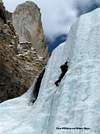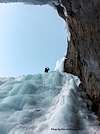-
 25006 Hits
25006 Hits
-
 89.01% Score
89.01% Score
-
 28 Votes
28 Votes
|
|
Area/Range |
|---|---|
|
|
52.14361°N / 117.04472°W |
|
|
Ice Climbing |
|
|
Winter |
|
|
Overview
The Icefields Parkway is a Canadian highway (93) that runs 230kms from Lake Louise in Banff National Park to Jasper in Jasper National Park. It parallels the Continental Divide as it splits the Canadian Rockies and crest two mountain passes, Bow Pass and Sunwapta. There are some serious waterfall ice routes dripping down glaciers and mountains along both sides of the parkway. The Columbia Icefield, just one of several icefields/glaciers that straddle the parkway, feeds the Pacific, Atlantic and Arctic oceans. The ample moisture and cold weather coupled with the steep terrain produce some of the finest waterfall ice routes anywhere in the world. Grizzly, black bear and moose crossings are a common occurrence on this stretch of road.
The parkway can be closed in the winter, and thus it is imperative to check on road conditions before planning your objectives. Avalanches can close the road even while you are on an objective, so always be prepared to spend several nights in the area if necessary. The Rampart Creek Hostel is a great place to center oneself for a week long attack on the Icefield Parkway ice.
A national parks permit is required to travel on the Icefields Parkway; stations near Lake Louise and Jasper enforce this requirement. The maximum speed limit is 90 km/h (56 mph) although your speed can be reduced to a crawl in winter conditions and the road does close regularly. Chains or all-season radial tires are actually required by law. There are no open services (read gas) open on the Icefields Parkway in the winter. Load up in Lake Louise or Jasper.
Listing routes with no first hand experience available is not what this page is about. Rather the listing involves first hand accounts only of waterfall ice routes that can be reached via the Icefields Parkway. The routes will be listed and maintained in ascending order of South to North. I can assure you that this listing only scratches the surface of what is available come January through April up and down the central Canadian Rockies. I personally attempt to climb 30 WI routes per winter and still have plenty more to experience.
Route Description(s)
Bow Falls, III, WI 4- This is a 3000’+/- ascent day. Bow Falls is 100+/- meters of ice that is sourced by a glacial lake (unseen from below) that lies in a basin below the receding toe of the Bow Glacier on the Wapta Icefield. Early 20th century photos show the glacier ice once flowed right over the cliffs where the falls now form. Bow Falls make up part of the headwaters for the Bow River which is the main tributary that flows through Banff National Park, the Banff town site, Canmore (outside my backdoor) and through Calgary. Bow Falls is located in Banff National Park, one of four connecting national parks making up the central Canadian Rockies.Mount Murchison
Murchison Falls, III, WI 4+- This is a 3000’+/- ascent day. Murchison Falls is a classic route along the Icefields Parkway due mostly to its aesthetics and length. As WI 4 and 5’s go, I have been on better routes. Murchison is a popular route however and gravitates towards the top of most tick lists. It is a four pitch route that can be done in three pitches if you solo the first step of ice. The three remaining pitches are quite long and 70m ropes are highly advised if you have them available. Murchison Falls is one of 18 routes located among three cirques on the western flank of Mount Murchison.
Mount Wilson
Wilson Major, III, WI 4- This is a 2000’+/- ascent day. The ideal time to climb Wilson Major is during the winter months when Lady Wilson’s Cleavage is in shape so you can practically strap your crampons on from the car. We were looking for the last ice in May up and down the parkway and noticed Wilson Major was still in when coming back from Shades of Beauty farther north. What we failed to recognize or think much about was the bushwhack approach on either side of Lady Wilson’s Cleavage which was running falls on any steep sections. (photo) I went right and Adam went left to give us a better chance of failure I guess, but in the end climbers left had much less deadfall and was easier to navigate.
Cirrus Mountain
Snivelling Gully, II, WI 3- This is less than a 1000’ ascent day. The ice climb itself is approximately 180 meters. Your approach to the left corner of Weeping Wall will last all of 10-15 minutes. Leave the parking area and cross the road to ascend to the base of the broad Weeping Wall. Snivelling Gully will come into view to your left as it creeps up between the rock and ice to the top left hand corner of the lower Weeping Wall. It is four pitches in total. The first and last pitch are sustained for their grade, but the 2nd and 3rd pitches are more ice scrambling than climbing. Snivelling Gully’s four rap descent off of bolted chains and a tree is used by most parties climbing on Weeping Wall’s other routes, so look for traffic on weekends. We went on a Tuesday in late December and had the entire place to ourselves. You are more likely to have it to yourself if the road is in bad winter condition which can be a good strategy to avoid crowds as long as it is not closed or they close it while you are climbing.
Weeping Wall, WI 3-6- The Weeping Wall area on the Columbia Icefield Parkway is home to two of the most sought after waterfall ice climbing objectives anywhere, Polar Circus, 1600’ of V, WI 5 and Weeping Wall (tons of grades and lengths). The name of Polar Circus was derived from the original ascentor, Charlie Porter, who while complaining of suspect gear on the crux of the route, exclaimed the event was nothing more than a “Polish Circus”. Lower Weeping Wall itself is a curtain as wide as it is tall offering just about every grade level.
Polar Circus, V, WI 5- This is a 2300’+ ascent day. Polar Circus is called the “showpiece of the Canadian Rockies and a must for all climbers” by Joe Josephson in his reknowned guide book “Waterfall Ice, Climbs in the Canadian Rockies”. It is one of the most sought after routes anywhere in the world. Featuring 2300’+/- gain with over 1600’ of waterfall ice spread out over 9+/- pitches, Polar Circus is a classic to say the least. Charlie Porter is credited for naming the route while on first ascent when complaining about setting up a station on one of the steep pitches, referring to his situation as nothing more than a “Polish Circus”. Polish became Polar in the translation. Within Polar Circus is a feature named the Pencil which rarely forms to the ground, but when it does it is one of the finer WI 6 pillars anywhere.
Beauty Creek
Shades of Beauty, III, WI 4- Shades of Beauty is 120+/- meters of III, WI 4 ice dripping down the north flank of Tangle Ridge. Tangle Ridge is located on the east side of the Columbia Icefield Parkway in Jasper National Park. Shades of Beauty has at least one published accident report .
Rick Black Memorial Route, III, WI 5- "The Rick Blak Memorial Route is a fantastic ice climb that was named in honor of a Jasper resident who was tragically killed in a caving incident. It does not always form although it seems to have appeared more regularly over the last several years. When formed it provides a stellar 40 metre stretch of ice, that works its way through varied terrain and thin sections of ice. Protection can at times be challenging (bring your stubbies), but the climbing is rarely desperate. Rather this route is quite cerebral as you are forced to balance, stem and thoughtfully work your way through several crux sections before arriving at the chains."
Red Tape
You will be required to purchase a national park pass as you enter Banff National Park coming from the east on the Trans-Canada. This pass is good for all four national parks. If you plan many visits to Canadian National Parks within one year, you should purchase an annual pass. There are no permit requirements to climb in Banff or Yoho National Parks, but all camping is regulated. There is also a backcountry permit required if you plan on spending a night in the backcountry versus the conventional campsites. This can be obtained via the parks website which is included in the camping section below. The huts are managed by the Alpine Club of Canada versus the Parks. The Alpine Club of Canada headquarters is located in Canmore, AB; the Banff National Park headquarters is located in Banff, AB; and Yoho National Park headquarters is located in Field, BC. You will drive through the manned national park kiosks as you enter Banff National Park on the Trans-Canada. You will drive through a kiosk area again as you gain the Icefields Parkway. However, it is normally not manned in the winter.Camping/Lodging
The Rampart Creek Hostel is several miles north on the Icefields Parkway and serves as a good base for all waterfall ice climbs in the area. Rates for dorm style were $23-$27 in 2006. It has 24 beds and reservations are recommended. They were having problems with water and power in 2007 and were closed periodically as a result. It would be advised to call ahead, (866) 762-4122.Mountain/Route Conditions
The Banff National Park website has weather, wildlife reports, trail closures, etc. Outside of the parks websites, Canadian Avalanche Association is also useful, particularly for winter travel. Canadian Alpine Accident Reports is also extremely relevant.DowClimbing.Com










